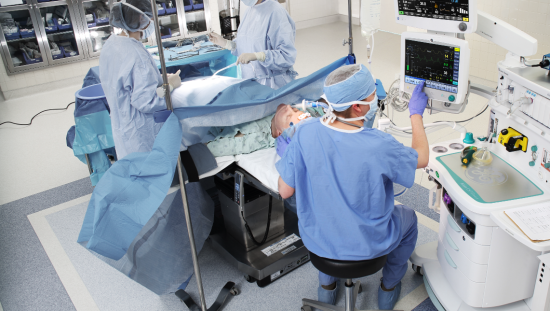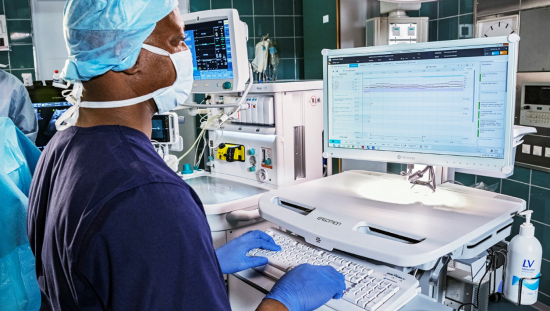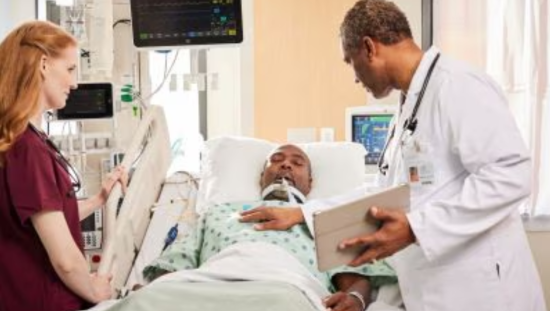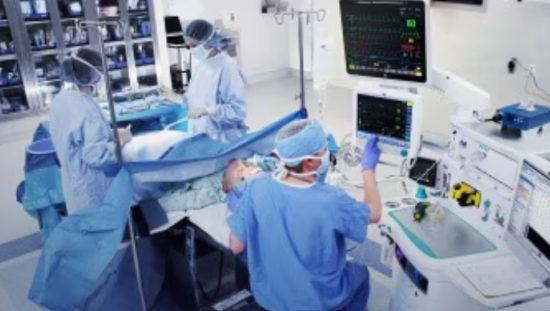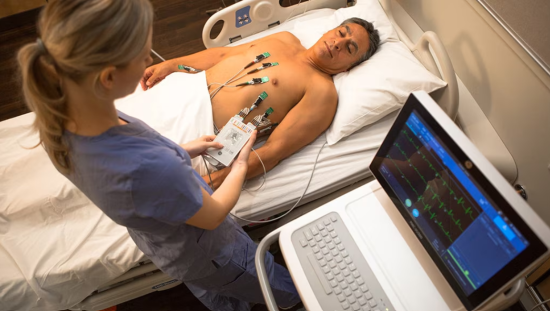Is your hospital vulnerable?
Recent industry changes are making it increasingly challenging for clinical engineers to keep pace with device management needs. As hospitals and health systems acquire more complex and connected devices, many clinical engineers are also navigating resource constraints, skills and training gaps and cybersecurity concerns. These difficult dynamics—if left unaddressed—place hospitals and health systems at higher risk of device management problems.
Why it’s time for a new approach
Without additional resources and support for clinical engineers, hospitals are more likely to experience lost or misplaced devices, equipment problems, unexpected equipment downtime, and missed software updates or security patches. That, in turn, may result in significant consequences, such as operational inefficiencies, lost revenue, reputational damage, clinician dissatisfaction and patient care delays. This playbook can help your organization create a plan of action to mitigate these challenges and ensure optimal device management. In the following pages, you’ll learn the:
- Top five challenges clinical engineers face
- Biggest risks these challenges pose for patients, hospitals and health systems
- Solutions to consider that help address these challenges

“When we work on a device, we work on it as if one of our loved ones is going to be the next one to need it. That’s something we all take to heart.” - Christopher Street Clinical Engineer, California
Challenge #1: Ensuring optimal equipment uptime
Clinical engineers are responsible for optimizing device uptime and reducing downtime. As hospitals and health systems acquire more devices, it’s becoming increasingly difficult for clinical engineers to proactively maintain all equipment and execute repairs quickly. A recent survey of clinical engineers found that more than 56% of respondents characterized their workload as “heavy” or “excessive,” underscoring the problems that clinical engineers face in completing their day-to-day maintenance and repair efforts.1
Risks
When proactive maintenance and repairs lag, potential risks include unexpected equipment downtime, costly repairs, care delays and disruptions, and clinician dissatisfaction.
Solutions
While many hospitals and health systems tend to engage in limited warranty programs when acquiring new devices, opting for more extensive device warranty programs can help support proactive maintenance efforts and timelier repairs. This includes:
- On-site and repair center options for corrective repairs
- Quick access to original equipment manufacturer (OEM) parts and next day delivery
Remote technical support services are another resource for hospitals and health systems to consider providing their clinical engineering teams. With remote support, clinical engineers have immediate access to support, rather than needing to wait for an individual to meet them on-site. This includes:
- 24/7 telephone support
- Secure video support calls
- Remote-in support
Remote support can be an extremely effective option for quick and efficient equipment repairs, as 66% of device problems can be fixed remotely.2
“Clinical engineers are an integral component of patient care and patient safety, yet we’re facing significant challenges that threaten our efficiency and jeopardize care delivery.” - Mark Huy Clinical Engineer, Illinois
Challenge #2: Managing more complex and connected devices
Connected devices are becoming an extremely common and critical aspect of healthcare delivery. It’s estimated that each patient bed has an average of 10 to 15 connected medical devices.3 For many clinical engineers, the growing number of connected devices is resulting in additional responsibilities, including the need to regularly apply updates, upgrades and security patches.
Risks
When clinical engineers struggle to keep pace with connected device management and maintenance needs, potential risks include cybersecurity breaches, device compatibility and performance problems, shorter equipment lifecycles, and loss of device to network data transfer.
Solutions
Hospitals and health systems should consider providing their clinical engineering teams with hardware system, software and device protection programs that may help enhance and streamline connected device management and lessen the financial and scheduling burdens associations with ensuring devices are up to date. This can include:
- Software updates and OS patches
- Software and/or hardware-based system upgrades
- Clinical software and/or hardware system upgrades
Engaging in a service agreement can also help clinical engineers manage the influx of complex and connected devices through agreements that include:
- Always-on communication, verified OEM parts and services and industry-leading AI tools
- Lifecycle management (planning, procurement, upgrades and retirement)
- On-demand services for fast repairs with OEM parts
$11 million the average cost of a healthcare cyber attack.4
“It used to be much easier to diagnose and fix device problems. Now, every device has a different structure, and every product has different components.” - Michael Serpe GE HealthCare Senior Services Staff Member and a former clinical engineer
Challenge #3: Navigating gaps in skills and expertise
As biomedical devices become more complex and connected, the skillsets required to manage those devices are evolving. As a result, many clinical engineering teams are experiencing gaps in skills associated with optimal maintenance, troubleshooting and security on certain devices.
Further fueling concerns related to skills and expertise gaps is the closure of many academic training programs for new clinical engineers, as well as the fact that one-third of the current workforce is nearing retirement age.5
Risks
When gaps in skills and expertise occur, potential risks include troubleshooting and repair delays, poor device performance and clinical engineer retention challenges.
Solutions
As hospitals and health systems invest in new biomedical devices, ensuring clinical engineers have access to training opportunities should be a top priority. Training should include:
- Detailed troubleshooting and maintenance including operations, software configurations, hardware and communication
- Processes, protocols, and procedures for upgrades, updates and patches
- Specialized training on device and cloud security
In order to enhance information retention and engagement, hospitals and health systems should also provide clinical engineers with training in a variety of formats, including:
- Hands-on in-person training at an OEM facility or at the customer’s location
- Self-paced or virtual instructor-led training
“In addition to managing, maintaining and repairing connected devices, clinical engineers need to be able to troubleshoot any network and connectivity issues that arise. This requires a different skill set.” - Mark Huy Clinical Engineer, Illinois
Challenge #4: Tracking and monitoring an expanding fleet
Clinical engineers are responsible for ensuring biomedical devices are always ready for patient care, whenever and wherever clinicians need them. Yet with thousands of devices, parts and accessories to keep track of, this is extremely challenging. As hospitals and health systems acquire more devices, it is growing even more difficult.
According to estimates from Fortune Business Insights, the global medical devices market is expected to grow from USD 542.21 billion in 2024 to USD 886.8 billion by 2032, with a key contributor being the rising number of surgical procedures globally.6
Risks
When clinical engineers lack resources that support efficient fleet tracking and monitoring, including network infrastructure, potential risks include lost time searching for devices, misplaced devices, loss of device-to-network data transfer, device security vulnerabilities and clinician dissatisfaction.
Solutions
Real-time location tracking solutions can play a key role in helping clinical engineers efficiently track and monitor their fleet and their network infrastructure. Benefits of these solutions include:
- Less time spent searching for equipment
- Enhanced productivity and efficiency
- Enhanced inventory counts and asset distribution
- More visibility into equipment utilization
Asset management and network monitoring solutions can also enhance device and network security by alerting clinical engineers to potential device or network problems or risks.
Other benefits include the ability to view and organize devices and fleets, proactively manage potential vulnerabilities, and proactively identify network performance changes while reducing the risk of patient data loss.
From 24 minutes to just 4 minutes
Mobile equipment moves throughout the hospital from one user to another, making it difficult to find and maintain an accurate inventory. Real-time location tracking solutions can help. For a small- to-medium sized hospital, this could mean decreasing the average time spent searching for equipment from 24 minutes to four minutes after implementing a remote asset management solution.7
“Remote tracking and inventory solutions can help eliminate time-consuming searches and enhance visibility into opportunities to improve device health. This empowers clinical engineers to work more efficiently and strategically.” - Kristen Suessmann GE Healthcare Senior Director of Healthcare Technology Management Operations
Challenge #5: Dealing with multiple vendor source parts and accessories
Clinical engineers have multiple options for acquiring new source parts and accessories, however, researching options takes time and effort. Accurately determining part reliability and efficacy is not easy.
Risks
When clinical engineers lack an efficient and reliable process for selecting parts and accessories, potential risks include wasted time researching options, utilization of less reliable and efficient parts, poor device performance, and reduced device longevity.
Solutions
Hospitals and health systems should consider providing clinical engineers with online access to a curated portfolio of parts and accessories that highlights the most reliable and compatible parts available for their biomedical devices. This may help streamline and enhance the selection process.
Hospitals and health systems should also recommend that clinical engineers should opt for OEM replacement parts, whenever possible. While OEM parts are sometimes more costly, they last longer and are more reliable. Over time the cost of ownership tends to balance out. Since parts and repairs go hand-in-hand, access to a trusted partner that can provide off-site repairs is important. The most effective repair operations center partners:
- Streamline the repair process by providing a shipping box and label
- Provide OEM-certified repairs with factory-approved parts and technicians
- Provide an average turnaround time of less than five business days
4 key advantages of OEM parts
- Quality: Meet the highest quality standards
- Reliability: More reliable and minimize the risk of equipment failure
- Compatibility: Integrate seamlessly with your equipment
- Ease: Eliminate the need to research and search for other options
Finding the right match for your clinical engineering team
Hospitals and health systems should explore additional opportunities to support their clinical engineers. The suite of service offerings from GE HealthCare Patient Care Solutions can help. These offerings, which are fully customizable and can be scaled up or down as your needs change, include:
- Extended warranty programs
- Remote technical support programs
- Enhanced system, software and device protection programs
- Specialized technical training programs
- Remote asset management solutions
- Parts, accessories and off-site repair solutions
©2025 GE HealthCare GE is a trademark of General Electric Company used under trademark license. Reproduction in any form is forbidden without prior written permission from GE HealthCare. Nothing in this material should be used to diagnose or treat any disease or condition. Readers must consult a healthcare professional.
JB31968XX
Learn more about how we can help your organization thrive
- “HTM Salary Survey 2023,” 24x7 Magazine, last modified January 25, 2025
- Devices include Patient Monitoring, Diagnostic Cardiology, Anesthesia and Respiratory, and Maternal and Infant Care. PCS 2022 Internal Data (data from FCR dashboard in service suite).
- Heather Landi, “82% of healthcare organizations have experienced an IoTfocused cyberattack, survey finds,” Fierce Healthcare, last modified August 29, 2019
- Nathan Eddy. “Healthcare cyberattacks are costing an average of $11 million per breach,” Healthcare Finance News, June 2024.
- “HTM Salary Survey 2022,” 24x7 Magazine, last modified January 27, 2023
- “Medical Devices Market Size, Share & Industry Analysis, By Type (Orthopedic Devices, Cardiovascular Devices, Diagnostic Imaging, In-vitro Diagnostics, Minimally Invasive Surgery, Wound Management, Diabetes Care, Ophthalmic Devices, Dental Devices, Nephrology, General Surgery, and Others), By End-User (Hospitals & ASCs, Clinics, and Others), and Regional Forecast, 2024-2032,” Fortune Business Insights, last modified October 7, 2024
- In a small to medium size hospital (100-300 staffed beds), based on average 24-minute search time without Encompass, and four-minute search with Encompass.


